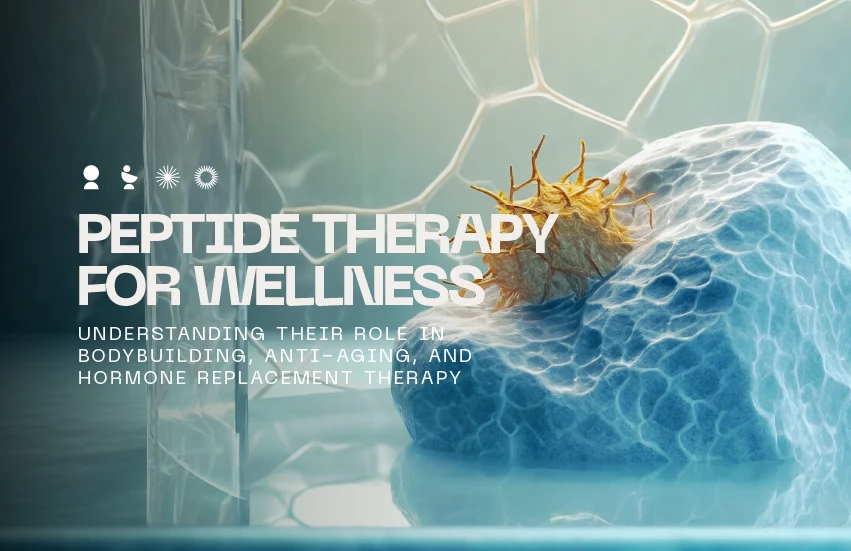Blog
Debunking Myths: CJC/Ipamorelin and Cancer Concerns

Contents
But first: what is CJC/ipamorelin?
Common cancer concerns
The scientific evidence
Debunking myth 1: CJC/ipamorelin causes cancer
Debunking myth 2: Increased risk of tumor growth
Debunking myth 3: Peptide therapy linked to cancer
The role of peptides in cancer research
Peptide therapy best practices
Busting myths with facts
Is CJC/ipamorelin a powerful peptide therapy or a cancer-causing catastrophe?
CJC-1295 and ipamorelin are growth hormone (GH) secretagogues. They’re known for their anti-aging, fat reduction, and other regenerative benefits. But concerns abound about their potential links to cancer.
So let’s uncover the facts behind the fiction. Join us as we dispel the myths with reliable research and science-backed studies.
Ready for a good ‘ol debunking? Let’s get into it.
But first: what is CJC/ipamorelin?
CJC/ipamorelin is a synergistic combination of two synthetic peptides.
Now, peptides are like smaller versions of proteins. They’re short-chain amino acids that naturally occur in the body. These building blocks regulate and facilitate countless biochemical processes.
Together, CJC-1295 and ipamorelin amplify and sustain growth hormone (GH) secretion.
Before we get into the benefits of this peptide therapy, let’s look at how these peptides work.
What is CJC-1295, and how does it work?
CJC-1295 is a synthetic analog of growth hormone-releasing hormone (GHRH). Once inside the body, it binds to GHRH receptors on the somatotropes. These cells are the most abundant type in the “master” gland, called the pituitary.
Like natural GHRH, CJ-1295’s binding action stimulates GH production and secretion. But it does so in an episodic manner. This allows for a more sustained release of growth hormone. The peptide also increases insulin-like growth factor 1 (IGF-1).
CJC-1295’s unique mechanism of action works in harmony with the endocrine system. This means it contributes to homeostasis (balance) and negates excess GH. It does so without affecting other hormones like cortisol, prolactin, and aldosterone.
Unlike natural GHRH, CJC-1295 stays in the body longer. This is due to a modification called a drug affinity complex (DAC). It’s a bioconjugation platform that allows the peptide to bind to serum albumin, a blood protein.
(Non-modified CJC-1295 is usually identified as such. It’s typically labelled “CJC-1295 without DAC” or “CJC-1295 No DAC.”)
The result is a much longer duration of bioavailability. Generally, a peptide’s half-life ranges from 2–30 minutes. In stark contrast, CJC-1295 has a half-life of 8–10 days.
Science-backed benefits of CJC-1295
The prolonged action and effects of CJC-1295 make it a potential therapeutic agent. GH and IGF-1 facilitate innumerable bodily processes. They affect the growth of various tissues, including muscle, bone, and collagen.
As a human growth hormone (hGH) analog, this peptide has various potential benefits.
Research shows that:
- One dose of CJC-1295 can increase mean plasma GH levels by 200% to 2,000%. The effects are sustained, lasting at least six days in healthy adults. (Teichman et al., 2006.)
- The CJC-1295 peptide also preserves GH pulsatility. This is crucial for many of the growth hormone’s physiological actions. (Ionescu and Frohman, 2006.)
- A single dose of CJC-1295 can boost IGF-1 levels by 150% to 300%. This lasts 9–11 days in healthy adults. (Teichman et al., 2006.)
CJ-1295 has significant performance-enhancing effects. It’s banned by the World Anti-Doping Agency (WADA) for this reason.
What is ipamorelin, and how does it work?
Ipamorelin is an artificial pentapeptide that mimics ghrelin. As a growth hormone secretagogue, it induces GH release.
But unlike other GH-stimulating peptides, ipamorelin has a selective mechanism. It specifically targets GH release. It does this without impacting other hormones, like cortisol.
Ipamorelin works by binding to the growth hormone secretagogue receptor (GHSR). Found in the brain’s pituitary gland, GHSR stimulates GH secretion. This, in turn, influences various anabolic processes, including:
- Energy usage
- Appetite regulation
- Fat processing
The GHSR receptor is also present in the gastrointestinal tract, immune cells, adipose tissue, kidneys, heart, lung, and liver.
Science-backed benefits of ipamorelin
Ipamorelin functions mainly as a GH secretagogue. It has a specific GH-releasing action that affects diverse physiological processes.
Studies suggest that ipamorelin can:
- Enhance bone growth and muscle mass. (Andersen et al., 2001.)
- Stimulate insulin secretion in the pancreas. The effect contributes to glucose homeostasis. (Adhegate and Ponery, 2004.)
- Improve gastrointestinal transit. This plays a significant role in appetite regulation and gut hormone signalling. (Venkova et al., 2009.)
The peptide boosts ghrelin levels, insulin levels, and cell synthesis. These actions work to promote lean muscle mass, strength, and weight loss.
CJC/ipamorelin as a peptide therapy
As peptide therapies, CJC-1295 and ipamorelin are often used in the context of bodybuilding, anti-aging, and overall wellness. The combination is thought to increase GH release more effectively.
CJC-1295 amplifies the intensity of growth hormone pulses. Its prolonged effects sustain GH levels, mimicking the body’s natural patterns during youth.
Ipamorelin boosts the frequency of these pulses. It has a shorter half life than CJC-1295. This allows for rapid GH release into the bloodstream.
Together, CJC/ipamorelin create a synergistic effect. Like sermorelin, these peptides stimulate natural GH and IGF-1 release. They’re often used in hormone replacement therapy to correct hormonal imbalances.
Growth hormone boosts lipolysis (fat breakdown) and increases metabolism. It maintains muscle mass, strength, and body composition later in life. IGF-1 has its own anabolic features. It promotes various tissue regeneration and growth, including bone and muscle.
Studies indicate that enhanced GH and IGF-1 can lead to:
- Better protein synthesis, fat loss, and muscle gain. IGF-1 also offsets excess GH levels. (Growth Hormone Related Diseases and Therapy by Morton G. Burt, 2011.)
- Improved cognitive function in healthy adults and GH-deficient subjects. (Creyghton et al., 2004.)
- Anti-aging benefits like increased bone mineral density. The peptides may also enhance extracellular matrix (joint tissue) production. (Dixit et al., 2020.)
- Better wound healing. GH and IGF-1 may stimulate epidermis and dermis cells. This action enables structural protein production. (Herndon et al., 1995.)
- Increased collagen production. This is due to growth hormone and IGF-1’s synergistic effects. (Brazilian Society of Dermatology, 2011.)
- Higher production of cytokines for better immune responses. These small proteins promote tissue repair. They also coordinate reactions to injury, stress, and infection. (Spaziani et al., 2014.)
- Improved sleeping patterns. Low IGF-1 levels are associated with obstructive sleep apnea. Thus, a sustained increase could enhance rest. (Galerneau et al., 2020.)
GH affects the immune, cardiovascular, and central nervous systems, too. It even plays a role in neurogenesis, sleep, and ageing. These features make CJC/ipamorelin a promising therapeutic agent.
But is it safe? Let’s unpack the facts.
Common cancer concerns
Despite its popularity, CJC/ipamorelin attracts a few cancer-related concerns. These myths include the following:
- Myth 1: CJC/ipamorelin causes cancer.
- Myth 2: Increased risk of tumor growth.
- Myth 3: Peptide therapy is linked to cancer.
But the internet is awash with contradictory information and complicated science speak. So how do you know what’s true and what’s not?
The following sections lay out a thorough examination of the evidence.
The scientific evidence
Myths that peptide therapies like CJC/ipamorelin cause cancer and tumor growth are widespread. But these concerns lack scientific backing.
They also have little to do with the peptides themselves. Rather, cancer concerns are related to growth hormone and IGF-1 levels in general, which CJC-1295 and ipamorelin affect.
The available scientific literature indicates the following:
On CJC/ipamorelin
CJC-1295 was reported to be safe and well-tolerated in healthy adults. The results emanate from two randomized, placebo-controlled, double-blind clinical trials. The findings were published in the Journal of Clinical Endocrinology and Metabolism.
Ipamorelin was well-tolerated in patients after bowel surgery. The results originate from a double-blind, placebo-controlled clinical trial. This study was published in the International Journal of Colorectal Disease.
On GH replacement therapy
Recombinant (synthetic) GH has been used for over 30 years. Its efficacy and safety are well documented. (Boguszewski et al., 2022.)
GH replacement therapy (GHRT) isn’t related to cancer incidence, cancer mortality, or all-cause mortality in children. It may trigger a secondary tumor risk, though. (He and Deng et al., 2022.)
The Growth Hormone Research Society found no link between GHRT and tumor return or the emergence of new cancers in cancer survivors.
It also found no association between GHRT and increased cancer mortality. Secondary tumor risk is low compared to other treatment-related factors. (Boguszewski et al., 2022.)
On exogenous GH vs. growth hormone secretagogues
Studies have linked exogenous (direct) growth hormone use to an increased risk of cancer. These and other health risks may be due to direct GH bypassing the body’s regulatory feedback mechanisms.
Growth hormone secretagogues have a potentially lower risk. They appear safe, according to current literature. Further research is needed to understand the effects of GHS on physiology. (Sigalos and Pastuszak, 2018.)
On IGF-1 levels
Elevated IGF-1 levels may be linked to an increased risk for some cancer types but a deceased risk for others. The researchers also found no association between higher IGF-1 and cancers like lung, kidney, or bladder cancer.
Reverse causality bias wasn’t excluded. (Knuppel et al., 2020.)
One review analyzed various studies on cancer risk and GH replacement therapy (GHRT). It found numerous biases and confounders in the available data.
Evidence in humans of a link between GH, IGF-1, and cancer is “conflicting” and “scarce.” No causal relationship can be established. (Cianfarani, 2019.)
On the GH-IGF-1 axis and tumor growth
GH controls IGF-1 production, which happens in the liver. IGF-1 then helps regulate GH release. This negative feedback loop forms part of the GH-IGF-1 axis. It comprises a complex ecosystem of proteins, receptors, and signalling pathways.
The GH-IGF-1 axis seems to play a role in certain cancers. Various tumors sustain their growth and division via specific IGF systems. Dysregulated IGF signaling seems to be a contributing factor. (Bleach et al., 2021).
But most of this evidence is epidemiological and experimental. The data in humans indicate an association between the GH-IGF-1 axis and cancer. There’s no direct causal relationship.
Environmental, nutritional, and genetic factors could account for these associations (Cianfarani, 2019.)
On peptides and peptide therapy
The body contains more than 7,000 known peptides. Their mechanisms of action aren’t always clearly defined. Some studies have highlighted cancer concerns related to specific types of peptide therapies.
Glucagon-like peptide-1-based therapy is a popular treatment for type 2 diabetes. But it’s linked to an increased prevalence of pancreatic and thyroid cancers. (Elashoff et al., 2011.)
The ghrelin family axis contains peptide genes that may serve as biomarkers for cancer. The receptors, proteins, and signal pathways are intricate and not well understood, though. Further research is needed. (Kotta et al., 2022.)
Conversely, some peptides show promise as cancer treatments.
One study found novel Arg-Gly-Asp (RGD) peptides were efficient in inhibiting and killing gastric cancer cells. (Wang et al., 2015).
The agonists of certain peptides have been shown to effectively inhibit cancerous growths in the prostate. (Schally et al., 2000.)
Even dairy-derived peptides have shown cancer-fighting potential. (Sah et al., 2015)
Debunking myth 1: CJC/ipamorelin causes cancer
So, does CJC/ipamorelin cause cancer? No definitive evidence currently proves a direct causal link between CJC-1295, ipamorelin, and cancer.
Peptide secretagogues like CJC-1295 and ipamorelin are designed to mimic natural biological processes. Their safety and tolerance are well documented in clinical studies.
As the evidence shows, concerns about growth hormone therapies and cancer are largely unfounded. The theoretical links between IGF-1 and cancer don’t represent a causal relationship.
Besides, the GH-IGF-1 axis is incredibly complex. Its role in cancer cell proliferation isn’t precisely understood. It requires more research.
Debunking myth 2: Increased risk of tumor growth
Do GH secretagogues like CJC/ipamorelin increase tumor growth risks? There’s no definitive link between such peptides and tumor growth.
These secretagogues indirectly stimulate GH and IGF-1 release. Some tumour cell types have IGF receptors. Their mechanisms aren’t entirely understood. Still, the risk of secondary tumor growth is minimal compared to other cancer risk factors.
Higher IGF-1 levels are associated with both an increased and decreased risk of certain cancer types. Researchers can’t definitively explain why. And reverse causality (where cancer would elevate IGF-1 levels) isn’t ruled out.
More long-term studies in humans are needed.
Cancer development is a multifaceted process. Genetic predispositions, environmental factors, and nutritional variables all impact it. As such, tumor growth can’t be attributed solely to peptide therapies like CJC/ipamorelin.
Debunking myth 3: Peptide therapy linked to cancer
Is peptide therapy linked to cancer? The current research doesn’t define a clear relationship between cancer and peptide therapies like CJC/ipamorelin.
Peptide therapies generally involve mechanisms distinct from carcinogenic processes. They can affect GH and IGF-1 levels. These, in turn, have nuanced biological functions. When present, cancer cells may interact with these functions.
A few studies show that specific peptides can affect certain cancers.
Some peptides, like glucagon-like peptide-1, may stimulate cancerous cell growth. Others, like dairy-derived peptides, may inhibit it. Still, the link between peptide therapy and cancer remains largely speculative.
The role of peptides in cancer research
Cancer research with peptides is ongoing. They’ve shown amazing potential for diagnosis and treatment. They also help researchers better understand the disease’s mechanisms.
For example:
- Peptides can be engineered to bind to cancer cells. This specificity allows for drug delivery directly to the tumor.
- Radio-labeled peptides are also used for diagnostic imaging. Their binding action makes them visible in imaging scans. This unique function enables early detection and monitoring.
- Anti-cancer peptides inhibit cancerous cell growth. They represent an exciting evolution of effective, less-harmful treatment.
- Peptide cancer vaccines can treat malignant disorders. Their ability to elicit and expand T cells can destroy tumors.
- Antimicrobial peptides have both anti-cancer and immunomodulatory effects. They’re able to inhibit inflammatory responses that promote cancer.
As fundamental building blocks, peptides are proving invaluable to cancer research.
Peptide therapy best practices
Peptide therapy like CJC/ipamorelin have loads of health-boosting benefits. But they require nuance and expertise to be effective. Here are three must-dos:
- Always consult healthcare professionals. You’ll get expert advice tailored to your unique needs. Once health conditions and suitability are assessed, a personalized treatment plan can be designed for maximum efficiency.
- Monitor and adjust dosages under medical supervision. This ensures safe and effective treatment that accounts for side effects and individual responses.
- Use peptide therapy responsibly. Doing so maximizes the benefits and minimizes the risks. More gains, less pain, anyone?
Busting myths with facts
CJC/ipamorelin is a peptide therapy with an array of anti-aging, muscle-growing, and performance-enhancing effects. It’s also surrounded by cancer concerns.
But the research speaks for itself.
CJC-1295 and ipamorelin stimulate growth hormone and IG-1 release. These effects in themselves don’t equate to increased cancer risk.
Still, every health decision requires careful consideration.
Understand the actual risks and benefits. Stay informed. Rely on the facts.
Book a consultation today for expert guidance and an individualized treatment plan.
Author: Dr. Jason Phan NMD – Founder of LIVV Natural – Anti-aging – regenerative medicine – peptide therapy


